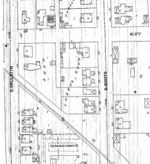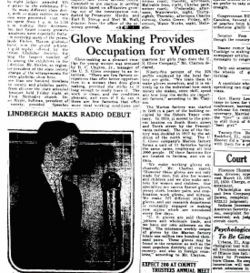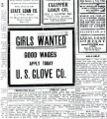U.S. Glove Company
Contents
The Life of the Glove Company
Introduction
At the turn of the century, Marion, Indiana, boasted several factories and industrial workplaces; however, most of these places of employment sought after only young, skilled men. Women of the time yearned for independence, freedom, and desired their rights to be recognized more than ever before. Acquiring a job to provide money was a surefire to elevate the status and power of women. The only problem—few businesses in the area hired women. That is, until the U.S. Glove Company came to town and developed Marion’s industrial appeal to women.
History
The Marion Fire Map of 1905 indicates that the Humphrey Lumber Company stood at the corner of 10th Street and Boots Street. However, the following Fire Map of 1920 shows the U.S. Glove Company replaced the former lumber piles, shed, and offices of the lumber business. According to the Fire Map, the U.S. Glove Company building contained six stations, electric light and power, steam heat, an automatic sprinkler system, and an alarm system (Fire Map 1920). In 1909, the U.S. Glove Company found its start in part of the building occupied by the Osborn Paper Company . In 1911, the U.S. Glove Company (See Appendix D) was established by a group of noteworthy men: George A. Osborn served as the President, R.J. Spencer as Vice-President, J.F. Charles as Secretary, and C.C. VanVactor as Treasurer (U.S. Marion City Directory, See Appendix E). George Osborn, also founder of the Osborn Paper Company in 1892, served the area as Franklin township trustee, county auditor, county superintendent of schools, and state senator (George Osborn Rites Planned, See Appendix F).H.C. Clayton, the manager of U.S. Glove Company, emphasized the abounding opportunities for women in the factory. Wanted signs ran in the paper (See Appendix G) and the owners spoke of pleasant working conditions in the factory, an uncommon thing of the time (Wanted). In fact, of the 325 people employed by U.S. Glove, ninety-five percent were female (Glove Making Provides, See Appendix H). The U.S. Glove Company then moved in 1916 to the location shown by the 1920 Fire Map at 10th and Boots Streets by the Pennsylvania Railroad (Fire Map 1920, See Appendix B). This factory is a unit of eleven factories bearing the same name at the time. Altogether, these factories employed 3,000 people. Five of the factories were in Indiana and the other six were located in Ohio (Glove Making Provides). Mr. Smaltz moved to Marion in 1908 and founded the U.S. Glove Company. Frank Smaltz and his son, Hugh Smaltz, secretary of Twin Seam Leather Palm Work Gloves from 1921 to 1923 (U.S Marion City Directory), left the local factory to start their own in Montpelier called Smaltz Glove Company (Frank Smaltz Rites Planned, See Appendix I) in 1927 (Smaltz Marion City Directory, See Appendix J).
Manufacturing
Though the factory changed names and hands over the years, from U.S. Glove from 1911 to 1931 to the Indianapolis Glove Company Branch from 1935 to 1955 (U.S. Marion City Directory, See Appendix E), this building produced a plethora of quality work gloves and mittens for men, women, and children (See Appendix K). The appeal for these kinds of gloves was at a premium since construction and factory jobs were at a peak. “We make working gloves exclusively. However, these gloves are not only made for men, but also for women and children and we also make mittens for women and children. Our specialties are Canton flannel gloves, jersey cloth, leather palm, and combination work gloves, and mittens. We make 727 different styles of gloves, and our research department is constantly engaged in making new styles which are introduced every few days,” stated Mr. H.C. Clayton, Jr., (Glove Making Provides) manager of the U.S. Glove Company at its start (U.S Marion City Directory). Of the women working at the factory, Clayton mentioned, “We train them to make gloves ourselves, and it is entirely up to the individual how much money she makes, since skill, speed, and how long she works are important factors.” (Glove Making Provides) The factory produced at a minimum one million two hundred thousand pairs of work gloves per week. These gloves were then sold through jobbers, wholesale trade, and through salesmen via catalogue books (See Appendix L). The variety of gloves, superior workmanship of the gloves, and quantity made them a highly demanded commodity all around. Other glove factories existed in the area, but none could compete with the U.S. Glove Company.
Current Times
Though the glove factory building no longer stands (See Appendix M), its impact on the city of Marion remains. Prominently displayed by the West entrance of the Marion Public Library is the sign that once hung over the entrance to the U.S. Glove factory . The glove factory, at the time of its operation, provided men, women, and children with high-quality work gloves to aid in the literal building and developing of the city of Marion. It also offered women a way to make their own money and thus gain power and independence. Looking back, one can easily see that the empowerment of women fueled by the glove factory has continued up to this day, since women are still working in the local areas of business at jobs once considered male-dominated. In addition, the glove company serves as a reminder to the city as to how far this region has come over the years; just as the glove factory changed and developed throughout its life and produced fine merchandise on a large scale, so too has the city of Marion grown and evolved.



















